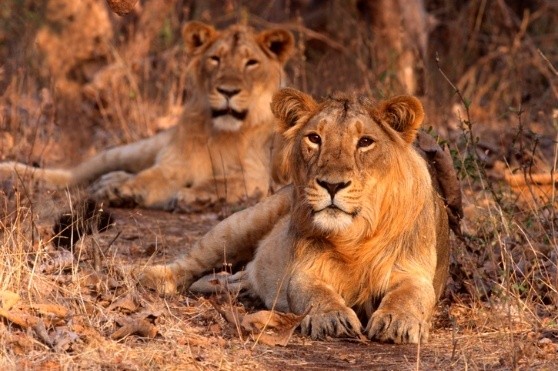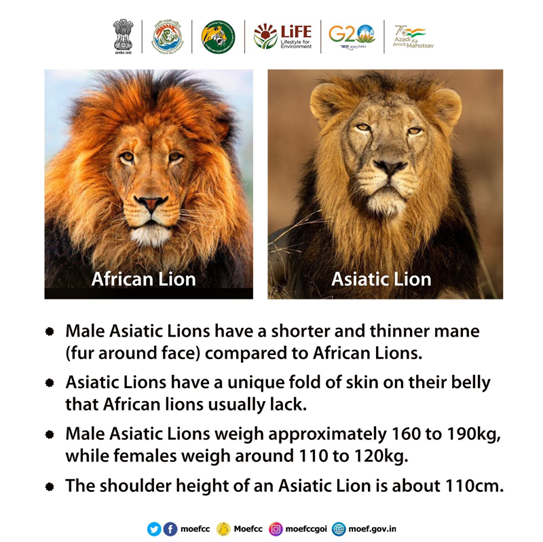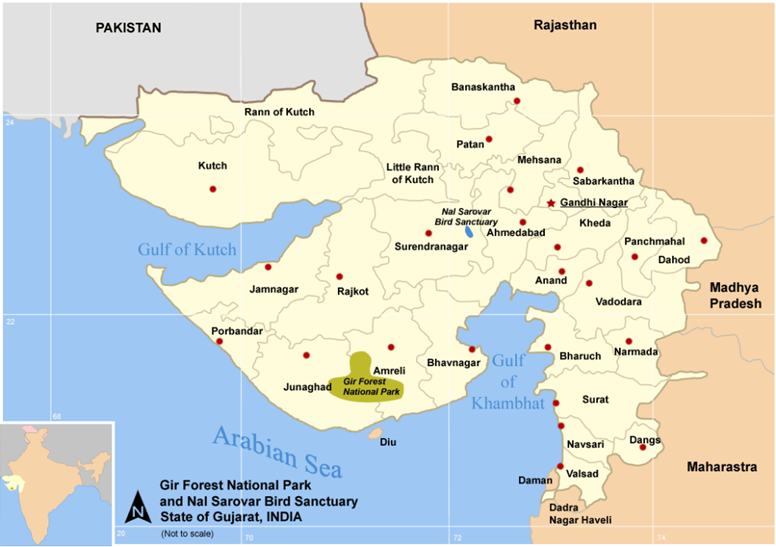- Courses
- GS Full Course 1 Year
- GS Full Course 2 Year
- GS Full Course 3 Year
- GS Full Course Till Selection
- Answer Alpha: Mains 2025 Mentorship
- MEP (Mains Enrichment Programme) Data, Facts
- Essay Target – 150+ Marks
- Online Program
- GS Recorded Course
- Polity
- Geography
- Economy
- Ancient, Medieval and Art & Culture AMAC
- Modern India, Post Independence & World History
- Environment
- Governance
- Science & Technology
- International Relations and Internal Security
- Disaster Management
- Ethics
- NCERT Current Affairs
- Indian Society and Social Issue
- NCERT- Science and Technology
- NCERT - Geography
- NCERT - Ancient History
- NCERT- World History
- NCERT Modern History
- CSAT
- 5 LAYERED ARJUNA Mentorship
- Public Administration Optional
- ABOUT US
- OUR TOPPERS
- TEST SERIES
- FREE STUDY MATERIAL
- VIDEOS
- CONTACT US
16th Asiatic Lion Census (2025)
16th Asiatic Lion Census (2025)

- In May 2025, Gujarat Forest Department Released 16th Asiatic Lion Census (2025)
- It Marks a significant progress in India’s wildlife conservation efforts, particularly for the Asiatic lion (Panthera leo persica), the only wild population of lions outside Africa.
Key Findings of the Census
- Total Population
- 891 Asiatic lions recorded in Gujarat in 2025.
- 32.2% increase from 674 lions recorded in the 15th Census (2020).
- Indicates successful conservation policies, habitat management, and reduced mortality.
- Population Distribution
- Protected Forest Areas:
- 384 lions reside in protected forests and wildlife sanctuaries.
- Non-Forested Areas:
- 507 lions now live outside traditional protected areas (up from 340 in 2020).
- This represents 44.22% of the total lion population, showing increased range expansion and habitat adaptation.
- Core Protected Region:
- Gir National Park and adjoining sanctuaries (Gir Wildlife Sanctuary and Pania Wildlife Sanctuary) host 394 lions.
- Pania Wildlife Sanctuary, also known as Chanchai-Pania, is a protected area in Gujarat, India.
- It's considered part of the Gir Wildlife Sanctuary and is particularly known for its role in conserving the Asiatic lion.
- The sanctuary, located in the Amreli district, is easily accessible from Amreli and Dhari.
- Declared a sanctuary in June 1989.
- Continue to be the stronghold of the lion population.
- Gir National Park and adjoining sanctuaries (Gir Wildlife Sanctuary and Pania Wildlife Sanctuary) host 394 lions.
- Protected Forest Areas:
- Noteworthy Areas
- Amreli District:
- Highest count with 257 lions, highlighting its emergence as a key habitat.
- Mityala Wildlife Sanctuary:
- Population doubled to 32 lions, indicating positive habitat utilization.
- Barda Wildlife Sanctuary (near Porbandar):
- 1st time lions recorded (17 individuals) since 1879 – a historical re-establishment.
- Satellite Populations:
- New lion populations identified around Jetpur and Babra-Jasdan, indicating natural range dispersion.
- Amreli District:
- Demographic Highlights
- 330 Adult Females:
- A 27% increase since 2020.
- A healthy sex ratio and reproductive capacity suggests positive future population trends and genetic viability.
- 330 Adult Females:
Background: Barda Dungar Sanctuary is the 2nd habitat of the Asiatic lion.
- Asiatic lions are found only in Gir Forest & other protected areas in Gujarat Saurashtra region.
- The Barda Wildlife Sanctuary was once home to Asiatic lions.
- But they vanished from the forest 143 years ago.
- In January 2023 A male Asiatic lion naturally recolonized the Barda Wildlife Sanctuary.
- So it is the return of Asiatic lions to the area after a long time.
|
About Barda Wildlife Sanctuary:
|
What is Project Lion: Backbone of Conservation
- Launched in 2020
- Objective:
- To create a secure and sustainable ecosystem for the long-term survival of Asiatic lions.
- Implemented in the Gir Landscape, which includes core, buffer, and dispersal zones.
- Key Components:
- Habitat Restoration: Improvement of grasslands, water sources, and removal of invasive species.
- Prey Base Strengthening: Conservation of herbivore populations for a balanced food chain.
- Human-Wildlife Conflict Mitigation: Installation of fences, awareness campaigns, and compensation schemes.
- Use of Technology:
- Radio-collaring and camera traps for tracking.
- Global Positioning System (GPS) based lion and vehicle monitoring.
- Automated Sensor Grids:
- Comprising magnetic, motion, and infrared sensors to detect lion movements.
- Geographic Information System (GIS):
- Enables real-time surveillance, rapid reporting, and proactive response to threats.
- Implementation:
- Led by the Gujarat Forest Department.
- Regular lion censuses and population health monitoring.
Census Methodology – Scientific and Efficient
- Direct Beat Verification Method:
- The landscape was divided into regions, zones, and sub-zones.
- Each unit was assigned to trained enumerators, supervisors, and volunteers.
- Lions were counted using direct sightings, evidence-based tracking, and GPS data.
- Efficiency:
- Completed in just three days.
- Compared to the tiger census, which takes up to two years, this method is more efficient and statistically robust.
What is IUCN Green Status of Lions (2025)
- The International Union for Conservation of Nature (IUCN) recently released its first Green Status Assessment for the lion (Panthera leo).
- The lion has been categorized as “Largely Depleted”.
- It is showing ecological degradation across much of its historic range.
About the IUCN Green Status of Species
|
Aspect |
Description |
|
Purpose |
Measures species recovery and the impact of conservation efforts. Complements the Red List by focusing on restoration and ecological function. |
|
Background |
Proposed by IUCN at the 2012 World Conservation Congress as part of broader “Green Lists” (for species, ecosystems, protected areas). |
|
Launched |
Conceptualized in 2021; officially integrated into the IUCN Red List in 2020. |
|
Difference from Red List |
Red List = Focus on extinction risk. Green Status = Focus on species recovery and conservation success. |
|
Recovery Definition |
A species is fully recovered if it:
• Is viable across that range • Performs its ecological role |
|
Green Score |
Percentage (0–100%) showing how close a species is to full recovery. |
|
Green Status Categories (9) |
1. Fully Recovered 2. Non-Depleted 3. Slightly Depleted 4. Moderately Depleted 5. Largely Depleted 6. Critically Depleted 7. Extinct in the Wild 8. Indeterminate |
|
Current Status (2025) |
Over 100 species have Green Status assessments on the IUCN Red List. |
|
Importance |
Highlights conservation progress, identifies recovery needs, and informs future actions—even for species not at immediate extinction risk. |
Key Findings of the Green Status Assessment
- Despite being classified as “Vulnerable” on the IUCN Red List, the lion is considered “Largely Depleted” under the Green Status.
- Major cause: Human activities have prevented lions from fulfilling their ecological roles, especially in regions where they were historically widespread.
- The lion is now extinct from North Africa & Southwest Asia.
- Conservation actions have prevented extinctions in key areas like:
- West & Southern Central Africa
- South Africa
- India (Gujarat)
- Despite conservation efforts, lions are still vulnerable due to increasing human settlements across their habitats.
- Concerns:
- Rapid human settlement expansion is threatening remaining lion populations.
- Need for intensified conservation measures to sustain and restore the species.
Lion Subspecies & Classification
- Previously, lions were divided into 2 subspecies:
- African Lion (Panthera leo leo)
- Asiatic Lion (Panthera leo persica)

The current classification by the IUCN SSC Cat Specialist Group:
- Panthera leo leo
- Found in West and Central Africa, and Asia (India).
- Includes the Asiatic Lion (Panthera leo persica).
- Panthera leo melanochaita
- Found in East and Southern Africa.
- Recognized since 2017 as a distinct subspecies (Southern Lion).
Asiatic Lion – Key Points for India
|
Feature |
Details |
|
Scientific Name |
Panthera leo persica |
|
Distribution |
Gir National Park, Gujarat (only wild population)
|
|
Protection Status |
- Schedule I of Wildlife Protection Act, 1972 - Appendix I of CITES - It was an Endangered on the IUCN Red List. But the IUCN has revised the Asiatic lion status to vulnerable in 2024 |
|
Habitat |
Dry deciduous forest, scrubland |
|
Unique Traits |
Longitudinal skin fold on belly (not seen in African lions) |
|
Historical Significance |
Once spread across West Asia and North India |
African Lion – Key Points
- Found across savannas, shrublands, and semi-arid deserts of Africa.
- Described by Linnaeus in 1758 (Systema Naturae).
- Genetic divergence:
- North and West African lions split from East and Southern African lions ~180,000 years ago due to climatic forest barriers.
UPSC Prelims (PYQ) (2019)
Q. Consider the following statements:
- Asiatic lion is naturally found in India only.
- Double-humped camel is naturally found in India only.
- One-horned rhinoceros is naturally found in India only.
Which of the statements given above is/are correct?
(a) 1 only
(b) 2 only
(c) 1 and 3 only
(d) 1, 2 and 3
Ans: (a)
|
Also Read |
|
UPSC Foundation Course |
|
| UPSC Monthly Magazine | CSAT Foundation Course |





